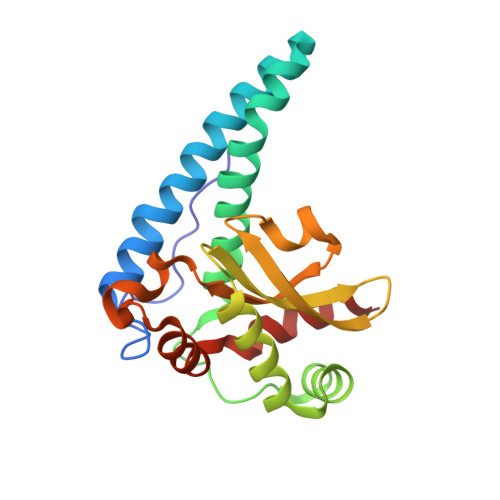Substrate-analog binding and electrostatic surfaces of human manganese superoxide dismutase.
Azadmanesh, J., Trickel, S.R., Borgstahl, G.E.O.(2017) J Struct Biol 199: 68-75
- PubMed: 28461152
- DOI: https://doi.org/10.1016/j.jsb.2017.04.011
- Primary Citation of Related Structures:
5T30, 5VF9 - PubMed Abstract:
Superoxide dismutases (SODs) are enzymes that play a key role in protecting cells from toxic oxygen metabolites by disproportionation of two molecules of superoxide into molecular oxygen and hydrogen peroxide via cyclic reduction and oxidation at the active site metal. The azide anion is a potent competitive inhibitor that binds directly to the metal and is used as a substrate analog to superoxide in studies of SOD. The crystal structure of human MnSOD-azide complex was solved and shows the putative binding position of superoxide, providing a model for binding to the active site. Azide is bound end-on at the sixth coordinate position of the manganese ion. Tetrameric electrostatic surfaces were calculated incorporating accurate partial charges for the active site in three states, including a state with superoxide coordinated to the metal using the position of azide as a model. These show facilitation of the anionic ligand to the active site pit via a 'valley' of positively-charged surface patches. Surrounding ridges of negative charge help guide the superoxide anion. Within the active site pit, Arg173 and Glu162 further guide and align superoxide for efficient catalysis. Superoxide coordination at the sixth position causes the electrostatic surface of the active site pit to become nearly neutral. A model for electrostatic-mediated diffusion, and efficient binding of superoxide for catalysis is presented.
- The Eppley Institute for Research in Cancer and Allied Diseases, 987696 Nebraska Medical Center, Omaha, NE 68198-7696, USA; Department of Biochemistry and Molecular Biology, 985870 Nebraska Medical Center, Omaha, NE 68198-5870, USA.
Organizational Affiliation:



















